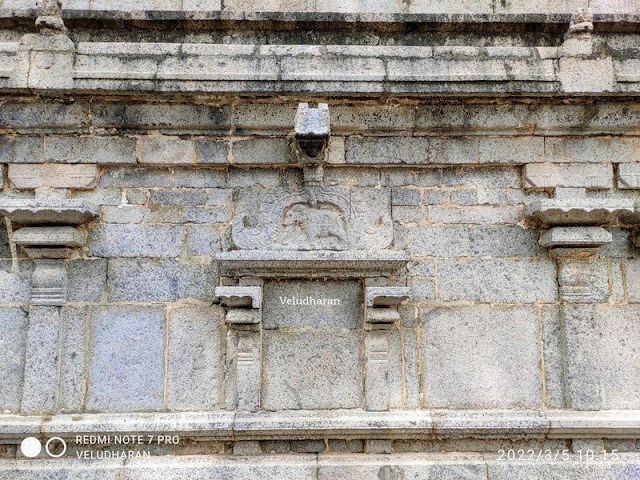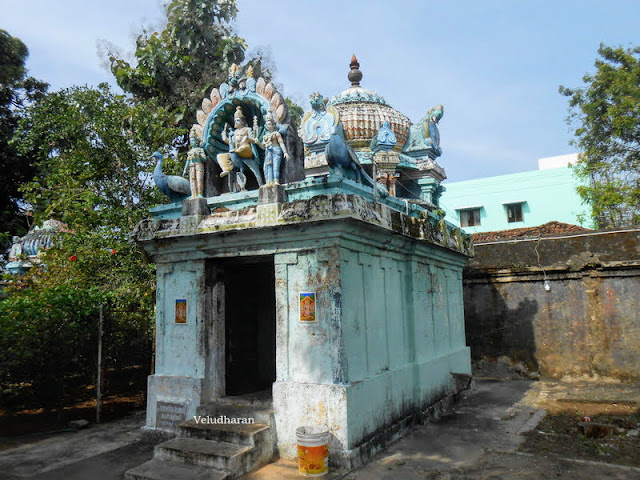The Heritage visit to this Sri Adhi Kayarohaneshwarar Temple near LIC, Sabam Theertha Vinayagar alias Kakka Kulam Pillayar Temple at Nagapattinam in Nagapattinam District was a part of “Mada Temples Heritage Walk in Nagapattinam and Mayiladuthurai Districts”, organised by “Chozha Mandala Varalatru Thedal Kuzhu – GCHRG, on 05th and 6th March 2022. This temple is about 750 meters from Sri Neelayadhakshi Kayarohaneswarar, one of the 276 Thevara Paadal Petra Shiva Temples. Thanks to V Ramachandran, Thasildar of Nagapattinam, who took us to all these Temples. The temple complex consists, Sattayappar Temple, a Mada temple and this Sri Adhi Kayarohaneswarar temple with Common parivara deities.
Moolavar : Sri Adhi Kayarohaneshwarar
Consort : Sri Adhi Neelayadhakshi Amman
Some of the salient features of this temple are….
The temple is facing east with a 3 tier Rajagopuram. Rishabam and balipeedam are in front of mukha mandapam. Moolavar in the sanctum sanctorum is on a vesara avudayar. Dwarapalakas are at the entrance of sanctum sanctorum. Saneeswaran is on the north side of the entrance. In koshtam Vinayagar, Dakshinamurthy, Lingothbavar, Brahma and Durgai. Ambal is in a separate sannidhi with abhaya varada hastam and back hands are holding akkamala and flower bud.
The parivara sannidhis in the praharam are ( Common for both temples ) Chandikeswarar, Ayyanar, Maha Ganapathi, Sri Valli Devasena Subramaniyar, Gajalakshmi, Saraswti, Nagars under Peepal tree, Navagrahas, Suryan, Thirugnanasambandar dancing and Bairavar.
ARCHITECTURE
The Temple consists of sanctum sanctorum, antarala, ardha mandapam, maha mandapam and muka mandapam. The Mandapam before the sanctum sanctorum and Ambal Sannidhi has the entrances on three sides. The centre entrance is connected to Mukha mandapam. Balipeedam and Rishabam are at the Mukha mandapam’s east entrance. The Mukha mandapam is supported by 3 square pillars with pushba pothyal. The side entrances are with 3 steps in Mughal architecture, built during Maratha’s period. The south entrance is with jumping yazhi pillars & pushpa pothyal. Stucco image of Neelayadakshi Ambal is on the top of the entrance. The Maha mandapam pillars has the basreliefs of Nachiapillai and his wife who had done thirupani to Sri Adhi Kayarohaneswarar and Sri Adhi Neelayadakshi Amman sannidhis with inscriptions.
The paintings of Lord Shiva’s ananda thandavam, Uma Maheswarar, Sattanathar, Dakshinamurthy are on the walls of maha mandapam.
Ambal sannidhi’s entrance is with Vishnukantha Pillars & sitting yazhi at the base. The Ambal temple adhistanam is of simple padabandha adhistanam, vedhigai, Brahmakantha pilasters, padra koshtas, The Vimana is of 3 tiers, the koshtas are empty. Stucco images of Amman’s various forms are in the Vimanam sala koshtam and greevam. Mukha mandapa koshtas are empty.
The main sanctum sanctorum is on a simple padabandha adhistanam with jagathy, threepatta kumuda and pattigai. The Bhitti starts with vedhigai, Brahmakantha pilasters with vettu tharanga pothyals. Koshta salas are padra koshtam. The prastram is with kapotam and viyyalavari. A two tier stucco vesara Vimanam is on the Bhoomidesam. Mahishasuramardini is on the north mukha mandapa koshtam. Dakshinamurthy sannadhi is added at a latter date with a separate sannidhi not abutting the main wall. Dakshinamurthy is sitting in veerasana, wearing maha and padra kundalam and holding snake, flame, and right front hand is in chin mudra, palm leaves suvadi in front left hand. Sanakatha munis are on both sides.
Meru mandapa is with seven steps. Mukha mandapam is small and the maha mandapam was built with brick and lime mortar. Kuda panchara is between maha mandapam and mukha mandapam. Maha mandapam and Vimanam are with Padabandha adhistanam, Vedhika, Vishnu kantha pilasters with padam, Pushba pothyals, mathalai in valapi and ends with kapotam. The Vimanam salas are as padra koshtas / protruding out side, greevam and Vesara sigaram. The Greeva koshtas are empty.
HISTORY AND INSCRIPTIONS
The Maha mandapam pillars has the bas reliefs of Nachiapillai and his wife who had done thirupani to Sri Adhi Kayarohaneswarar and Sri Adhi Neelayadakshi Amman sannidhis with inscriptions.
LEGENDS
It is believed that this temple was constructed before Sattainathar temple and Sri Kayarohaneswarar Temple, one of the 276 Paadal Petra Shiva temples, by Pundariga Munivar. There are different cults existed in worshiping Lord Shiva like Maakalam, Kapalikam, Lakuleesam, etc,. Of these Lakuleesam was practiced popularly in North India and Lakuleesar Statues are found in many parts of North India. The basic principle of this cult is to attain Lord Shiva’s feet with the mortal body ( Kayam = காயம், உடம்பு human body ).
It is believed that Pundarika Maharishi who practiced this Lakulisa Pasupata worshiped Lord Shiva of Kasi, Kanchipuram and Kumbakonam, where the Kayarohanam or Karonam temples are still exists. Hence this temple Shiva is called as Sri Kayarohaneeswarar. The Full legend goes like this....
When Pundarika Munivar wants to attain mukthi with his physical body, his father Karumathathan advised him to go and worship Lord Shiva of Kasi. There he worshiped Viswanathar Lord Shiva for 2000 years, but Lord Shiva didn’t gave darshan. Vamadeva Munivar advised him to go to Kanchi. Pundarika Munivar worshiped Kachi Karonam Shiva for another 12000 years. Here also Lord Shiva didn’t gave darshan. Instead Lord Shiva asked to come to Kumbakonam. Pundarika munivar came to Kumbakonam, established and worshiped Kudanthai karonam Lord Shiva for another 8000 years. Here Kanva Munivar advised him to go to Nagapattinam where he established Kayarohaneswarar and worshiped for many years. After satisfied his worship Lord Shiva told Pundarika Munivar, that he will give mukthi with his physical body on the 3rd Darshan. With Severe penance Pundarika Munivar attained mukti with his physical body on the third darshan. This legend of Pundarika Munivar attained Mukthi is celebrated every year on Aani month Ayilya nakshatra day.
POOJAS AND CELEBRATIONS
Apart from regular Poojas, special poojas are conducted on Pradosham, Maha Shivaratri days, Deepavali, Navaratri, Thirukarthigai, Pundarika Maharishi’s Mukthi day, etc.
TEMPLE TIMINGS
The temple will be kept opened between 07.00 hrs to 11.00 hrs and 17.00 hrs to 20 hrs.
HOW TO REACH
This temple is about 750 meters from Sri Neelayadhakshi Kayarohaneswarar, one of the 276 Thevara Paadal Petra Shiva Temples.
This temple is about 1.5 KM from Nagapattinam Railway station, 20 KM from Karaikal, 20 KM from Thiruvarur, 53 KM from Mannargudi and 303 KM from Chennai.
Nearest railway station is Nagapattinam.
LOCATION OF THE TEMPLE : CLICK HERE
--- OM SHIVAYA NAMA ---



























No comments:
Post a Comment